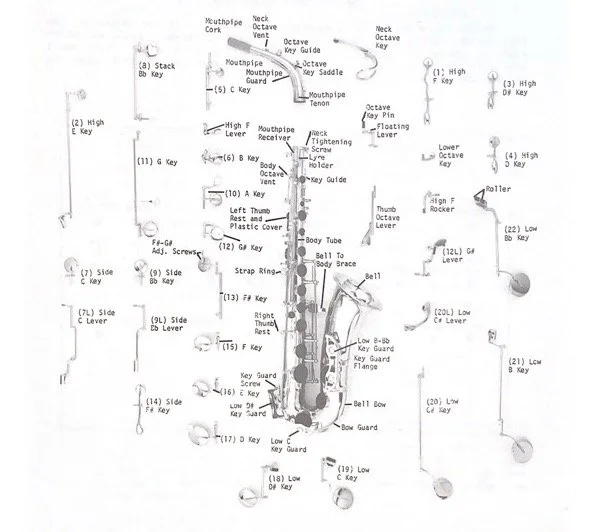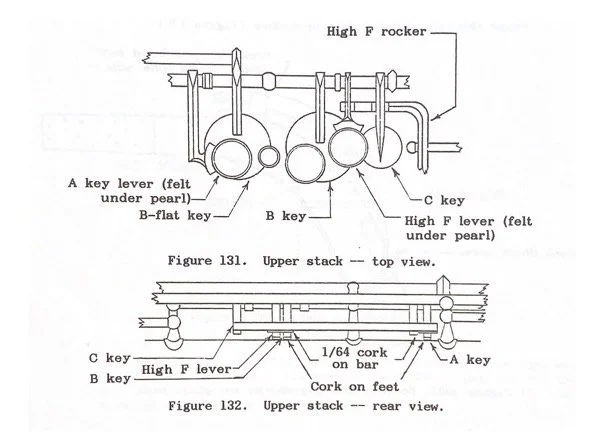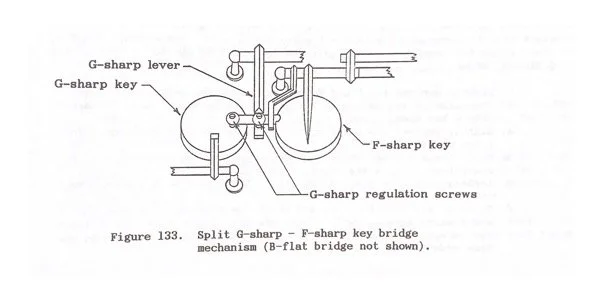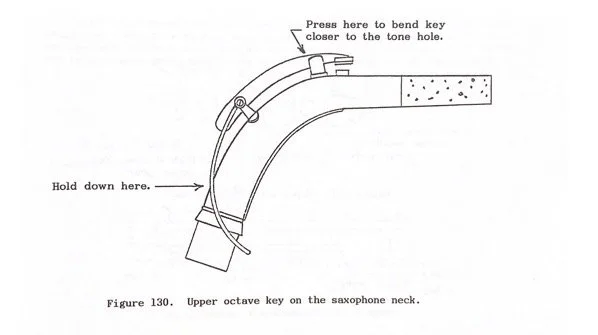How Much Does A Saxophone Service Cost?
Quoting and Costing:
How Much Does A Saxophone Service Cost in the UK?
There are a number of factors that can affect the overall cost of a saxophone repair, with prices varying from £35 to £50 if it’s small mechanical adjustments, to in excess of £500 if the instrument needs to be fully stripped and re-built.
To get an idea, understanding a few key bits of information about your instrument can help determine a rough estimate.
The make and model; Not all Saxophones are made equally, some are made with top-of-the-range manufacturing, and high-quality components, while others are made on a budget. In some cases, the cost of repairing a saxophone may outstrip its value.
The Age of the Instrument; A saxophone with many years of play will degrade the pads, key corks, and parts of the mechanism slowly over time. As a general rule, if it has had over 3-4 years of good play, the pads will be towards the end of their life.
The Date of last service; Regular servicing will mean you keep on top of any issues with your saxophone before they become major problems.
Below is a list of guide prices per job, For further information on the details of the individual process involved in servicing a saxophone read on, or don’t hesitate to get in contact with one of our team.
Saxophone Repair Guide Prices
All prices are subject to assessment and do not include parts
Individual Repairs - £30-£50
Neck Cork Fitting - £30
Dent Repair - £50-£90
Clean, Oil & Adjust - £90 - £100
Service Including Up to 3/5 New Pads - £130 - £150
Full Re-Pad/Overhaul - £350 - £450
Saxophone Clean and Oil:
How often does a Saxophone need cleaning?
Regular play can take its toll on any instrument, but with Saxophones specifically, there are a few common effects, from Rusted and Seized screws to sticking pads. Over time As you play the sugars in the saliva can build up deposits of debris on the surface of the pads and the tone tone which can cause keys to stick, most notably G# and Bb.
During a strip-down cleaning, all the key work is removed, and the body is cleaned thoroughly inside and out. A range of different products will be used to deal with, Grease, Dust and Rust. As well as this all screws are cleaned, and lubricants replaced. Tone Holes are also also lightly levelled to remove any corrosion.
Exploded Saxophone Key Diagram - From Elkhart Indianna
Saxophone Key Regulation:
When should Saxophone keys be adjusted?
Left Hand Key Regulation Diagram - taken from Roland Saska A Guide To Woodwind Repair
Sometimes the issue that’s causing the instrument to play badly is the result of the key work bending gradually, or that the small pieces of regulation material (felt/cork) have become worn over time, or fallen off. This stops the keys from closing together as they should.
During an assessment, the technician will establish if there are any issues with the saxophone key regulation and quote for how it can be corrected. It is not always the case that regulation is the same for each saxophone. Different models and makes have sometimes widely different mechanisms for how the keys function. What may just be a case of re-gluing some cork on one Saxophone, may involve removing whole sections of key work on another.
Saxophone Pad Replacement:
When do Saxophone Pads need to be replaced?
Saxophone Pads are usually constructed from a combination of felt and card, which is then coated in a shell of high-quality leather. The quality of the materials used as well as how the instrument is looked after will affect how well they produce a good seal against the tone holes on the instrument.
A technician will usually use a light that is put down inside the instrument to determine which keys are showing signs of leaks. As a general rule, Saxophone pads have a life cycle of about 3-4 years of play before they will need to be replaced. However, there are certain pads on the saxophone that due to receiving excess moisture will wear more quickly.
Replacing pads on a Saxophone is a very delicate process, Due to their size a good amount of heat, adhesive, and meticulous adjustment is needed to ensure the pads close and seal with a light finger press. This is one of the more costly aspects of the service so it can push up the price depending on how many need to be replaced.
Saxophone Dents:
How are Saxophone Dents Removed?
Accidents happen, and with even a small impact, the force can be enough to put a dent in the lacquered brass body of a Saxophone. Sometimes this will only be superficial or other times it may greatly affect the free movement of keys or alignment of the pads.
Different techniques are used to remove dents depending on where they are on the body of the instrument. But usually, it involves using a polished metal ball to apply force in the opposite direction of the impact to lift the dent out.
Neck Cork Replacement:
When does a saxophone neck cork need replacing?
The Neck cork on a saxophone is vital for forming both a strong seal between the mouthpiece and the body of the instrument, but also for being able to adjust the tuning on your saxophone.
If the neck cork is looking old and is beginning to crumble it may be a sign that it needs to be changed, in some cases the glue will dry up and the whole cork may cleanly fall off,
Common Issues:
What are some common issues with Saxophones?
Re-Soldering Posts
Some components of the saxophone (including most of the posts that hold the keys in place) are soldered onto the body. Over time the solder can degrade and loose parts can either fall off of or get knocked off from the impact.
Re-soldering is a fairly straightforward process, but it’s important to understand that the heat involved along with the corrosive nature of the flux used in the process can lead to some unavoidable scarring to the lacquer finish of the instrument.
G# and long Bb regulation
The Design of most modern Saxophones is such that as you go down into the lower register, C#, and below a special mechanism is implemented to key the G# key closed, without this functioning, the low notes will feel almost impossible to sound cleanly.
This mechanism is usually operated by either screw or a piece of cork attached above the F# key on a small rod of brass. We will always check this as part of any Saxophone Assessment as they quite frequently come out of regulation.
Saxophone G# / Long Bb Diagram - taken from Roland Saska A Guide To Woodwind Repair
Bent Octave Key Mechanism
A very common issue with saxophones is that the octave key on the neck can get slightly bent. This can happen gradually by tightly gripping the neck as it’s inserted into the body, it has the effect that all notes will play in the upper octave without the thumb key being pressed.
In most cases, this is a quick repair, and reversing the bent is enough to correct it.
Saxophone Octave Key - taken from Roland Saska A Guide To Woodwind Repair
Spring Replacement.
There are several springs on the clarinet which operate single keys or groups of keys, they take the form of both flat and needle style springs.
Broken Springs are common on older instruments where rust has been allowed to develop, or years of use has weakened the metal.
Neck tenon and receiver fitting.
The neck tenon is the joint that fits the saxophone neck to the body of the instrument, this should form a tight seal with just a quarter to half turn of the tightening screw.
there are a few ways in which this can get damaged, if small pieces of dirt get into the receiver, it can slowly rub and wear away at the metal which will lead to a weak fit. It may also be a result of a nock or dropping the neck.
If you have any questions regarding Saxophone Repair / Servicing please get in contact via the form below
Frequently Asked Questions
-
Once booked in, a typical service can take 2-4 days, it’s required to leave some time to allow new pads to settle in before play testing and final adjustments.
-
It’s recommended to have your saxophone serviced either 6-9 monthly to keep it in best playing order.
-
If the Saxophone only needs 2/3 pads replaced it could be between £55 to £85. Full Re-Padding can be between £400-£500 and more depending on the age of the instrument.
-
Over time, the lubricants in the keys can become congealed and lead the action to become sticky. this can be remedied by a full strip-down service.
-
Saxophone service costs vary depending on the age and condition of the instrument, typical service costs can be between £35 to £50 for minor adjustments, and as much as £400 to £500 plus if mulitple components need to be changed.






